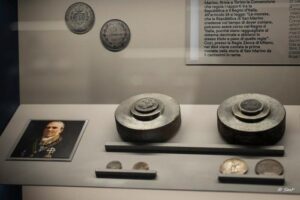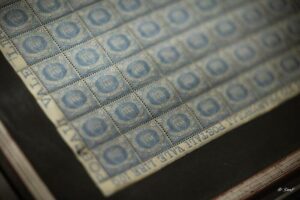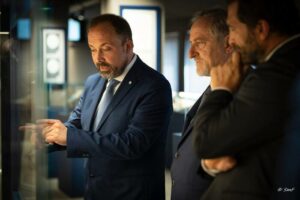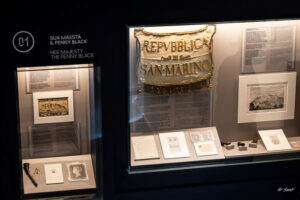
On Thursday, 8 July, the ribbon was cut at an opening ceremony and San Marino’s new Stamp and Coin Museum was inaugurated. The ceremony was attended by the two equal heads of state, the so-called Capitani Reggenti Marco Nicolini and Giancarlo Venturini, and by the Secretaries of State Andrea Belluzzi (Education and Culture), Stefano Canti (Environment) and Massimo Andrea Ugolini (Justice). At 5:30 p.m. the museum’s doors finally opened, more than two years after the project – which was pushed forward during the pandemic – had started.



The exhibition, which is located in the middle of the historic centre on the Monte Titano in Piazzetta Garibaldi, covers two large halls of more than 700 square meters. After more than two decades, San Marino gets an institution that promotes the national identity of the small state by telling its history by means of two special “ambassadors”: coins and stamps.
However, stamps and coins are not the only objects that await the visitors along the suggestive path, whose architectural work and furnishing were supervised by the architect Mirco Semprini. Documents and objects that were previously unknown or misinterpreted are on display too. The exhibition was curated by Roberto Ganganelli, who, after the unexpected death of the philatelic expert, was also in charge of the part of the exhibition dedicated to postal history.

San Marino’s Rich Numismatic History
Among other things, you can admire prototypes of coins and stamps made of bronze and plaster. The prototypes for the 1925 gold coins are marvellous, some of them are loans from the heirs of the artist Melchiorre Fucci. Other wonderful prototypes include those of the 1930s coins as well as later lire, scudi and euro pieces that were created by well-known artists such as Bino Bini, Guido Veroi and Laura Cretara. The exhibition comprises extremely rare patterns, projects and curiosities from private tokens of the “Circolo 5 febbraio” to magnificent ancient decorations of the Order of San Marino and Saint Agatha.

History in Stamp Format
At the same time, you can admire the philatelic department. The stamp issues are arranged systematically and chronologically from the beginnings to the 1950s. They are complemented by sketches, designs and projects that were never realized, including those of artists such as Rodolfo Viola, Aligi Sassu and Giacomo Manzù. They turn the museum into an art gallery focusing on the 20th century. In this way, texts and images guide visitors through San Marino’s history and traditions, illustrating the changing relationship between the microstate and the rest of the world.

Historical Objects from Garibaldi to Nixon
Among the historical objects there are pieces related to Garibaldi (to whom San Marino owes practically its existence), such as a pistol of the Italian national hero. Here you can also see a rare parade sword of a Capitano Reggente, rock samples from the moon (a gift from US President Nixon), handwritten documents, for example by Bruno Reffi on a medal commemorating Gianni Vidmer, who was the first aviator to land in San Marino. (However, the medal project was never realized.) There are many everyday objects illustrating San Marino’s economy in the 19th and 20th centuries and explaining why Italian money circulated at the same time.

An Exhibition for Everyone: From Tourists to Professionals
Roberto Ganganelli decided to create an exhibition that appeals to emotions and imparts knowledge at the same time, thus addressing experts and beginners alike – and even tourists, who will be taken on a journey through San Marino’s history encountering its historical figures and symbols.
But this journey will not be permanently the same. In both departments, the objects on display will change, illustrating, above all, the modern history of coinage and philately in ever new and different ways.
Proper special exhibitions are also planned: right now, visitors of the numismatic section can marvel at a medal collection by the artist and medallist Emilio Greco – presented in a restored 19th century coin cabinet from the Museo di Stato.
The philatelic department currently celebrates the Carabinieri, who opened a police station in San Marino exactly 100 years ago. The Italian post office has issued a special stamp for this occasion.

Big Plans for the Future
The Secretary of State Andrea Belluzzi said: “The life of the Stamp and Coin Museum has just begun, and the next step will be to open these premises also for events, conferences and educational projects.” The Director of the Cultural Institutes Vito Testaj praised this new “cultural offer of San Marino” as an “important result”. He hopes that another key museum can be completely redesigned, the museum for historical armour in the “Seconda Torre”.
“Even if it is your first visit in San Marino”, said the curator Roberto Ganganelli during the press conference, “you could just visit the Museum of Stamps and Coins.” The comprehensive exhibition of coins, medals, seals and coining dies that were previously kept in the State Archives, documents, images and other objects alone opens a window that offers a fascinating view of San Marino’s history.
In the same building there is now also a tourist information office and a newly designed sales point of the Philatelic and Numismatic Office of San Marino, where tourists and visitors can purchase newly issued coins and stamps of San Marino.
The museum’s opening hours are from 9:30 a.m. to 6:30 p.m. seven days a week.
You can find the museum on the website of the State Museums of San Marino.
The Stamp and Coin Museum also has a Facebook page.
If you want to know more about the curator of this exhibition, read our Who’s Who about Roberto Ganganelli.
By nature, San Marino’s history is closely connected to that of the Italian state. Find out more about Italian history and coinage in our series “From Lira to Euro: Italy’s History in Coins”.




